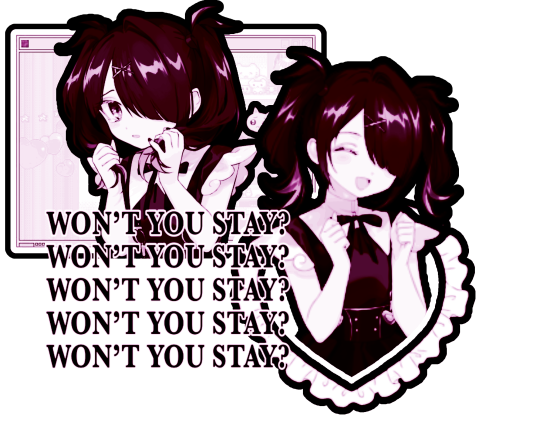#Content Overload
Explore tagged Tumblr posts
Text
i love being on the internet and summer and this day and age bc in the past month i've been through 3 fandoms (2 of which i've been in before) and learned about a new one. and guess what? THERES SO MUCH CONTENT!! i get it can be bad and overwhelming but im very happy for these few weeks
#hyperfixation#adhd#i have that#that might be why#summer#ohshc#maxley#descendants#ao3#content overload#def born in the right generation
9 notes
·
View notes
Text
another post-show making the ol' reblog button start to smoke!
5 notes
·
View notes
Text
social media won't let me rest 😫

Videodrome — 1983 Directed by David Cronenberg
6K notes
·
View notes
Text
working overtime to post these updates today holy...

0 notes
Text

#so cute i cant#catblr#cats of tumblr#cats of the internet#cute cats#cuteness overload#wholesome content#i love cats#eyebleach#caturday#tabby cat#plushblr#plushcore#stuffed animals#plushie#penguin plush#sleepy cat#sleepy cuddles#cuddling & snuggling
2K notes
·
View notes
Text
Nothing will stop this dog from protecting his owner
(Source)
#dog#dogs#dogs of tumblr#protect#aww#cute#animals#doggo#wholesome#wholesome content#babyanimalgifs#cute overload#video
2K notes
·
View notes
Text
ERROR 404: Overload!

PAIRING: svarog x mechanic!fem reader
TAGS & WARNINGS: dark content, dubcon (reader says it’s too much but svarog has a mission to collect data), rough sex, multiple rounds, dom!svarog, sub!fem reader, svarog is Massive, cervix mentions, tummy bulge descriptions, multiple rounds, overstimulation, size difference, power dynamics, size kink, fingering, unrealistic sex, robot fuckers unite!, can you tell i have a size kink?
WORD COUNT: 5.1k
SUMMARY: You discover the reason why Svarog wears pants.
© toshisdecadence

The repair bay smelled faintly of heated metal, coolant fluid, and faint traces of alcohol; a sharp tang that clung to the sterile air. You barely noticed it anymore, accustomed to the hum of machinery and the faint vibration of tools against metal. But today, that hum was louder, and the vibrations sharper, emanating not from your usual repair work but from the massive, battle-worn war machine sitting across from you.
Svarog loomed over the room, his 8’11 frame too large for the reinforced chair you’d hastily reinforced when he arrived. His joints hissed faintly, micro-servos struggling to compensate for the damage he’d sustained during the Wardance duel against Luka earlier that day. Faint dents marred his reinforced dark blue chest plating, and faint sparks sputtered from the exposed wiring along his arm.
You reached for your tools, hyper-aware of the pinkish-red glow of his cyclopean optical sensor tracking your every movement.
“Superficial damage sustained. Functionality remains above 90%. Repairs are non-essential.” His voice rumbled, a deep, mechanical timbre that sent a shiver up your spine.
You regarded him critically. “Non-essential? Your vents are overheating, and you’re rattling like a dying starship. Sit still and let me work.”
He didn’t argue. Svarog was nothing if not logical, and logic dictated that he allow himself to be repaired. Still, there was a tension to him, a stiffness beyond the rigid design of his armor. He didn’t like being examined, didn’t like lowering his guard to anyone else other than Clara, even in the hands of someone who statistically meant him no harm or stood a chance against him.
You stepped closer, tools in hand, and gently pressed against the plating on his shoulder. His frame vibrated under your touch, a subtle hum you might have missed if you hadn’t been so close.
“Core temperature stable,” he intoned. “Subsystems fully operational.”
“Your fans tell a different story,” you muttered, running diagnostics through a handheld scanner. “You’re burning hotter than you should be.”
Svarog didn’t respond right away, but you could feel his pinkish-red optic watching your hands as they worked, tracking each movement with the precision of an apex predator. The thought sent an odd warmth through your body, and you tried to shake it off.
You needed to focus.
The repairs took you lower, inspecting the dents along his torso plating. The main brunt of the damage he took from Luka’s mechanical arm focused around his torso. One of the seams had split, exposing a layer of reinforced polymer beneath the outer shell. Carefully, you reached for the damaged panel, fingers brushing against the edge of the pants covering his lower half. It was an unusual addition for a machine built for combat, and one that always raised questions in your mind.
You tugged lightly at the material, intending only to check the joints underneath, but your fingers brushed against something unexpected beneath the fabric.
Your breath hitched.
The surface wasn’t the cold hardness of metal or the pliable texture of synthetic padding. It was smooth, warm, and distinctly… organic in shape.
You froze, pulling your hand back as though burned.
His optic dimmed slightly in a flicker that you’d come to recognize as his equivalent of a blink.
You swallowed down the saliva that had gathered in your mouth, gesturing vaguely at his lower half, struggling to form the words.
Svarog tilted his head, the motion eerily human. “This component was included in my original design for biological infiltration protocols.”
You stared at him as if he grew a second head. “Biological… infiltration?”
“My model is the third series of the Monitoring Automaton Prototype, engineered to simulate human anatomy. The purpose was strategic manipulation through intimate interactions if required by mission parameters.”
Your throat felt dryer, and the question that left your mouth sounded ridiculous even to you. “You’re telling me someone thought it’d be a good idea to put a dick on a war machine?”
“Affirmative.”
His voice remained perfectly calm, but your face was burning. A sneaky glance at his lower half rendered you speechless once again. Whoever designed Svarog certainly made his… appendage proportional to his hulking body.
You tried to laugh it off, but the sound came out strained. “And… what? You’ve just been...” You made an awkward gesture with your hand, “carrying it around this whole time?”
“Correct. The feature has never been activated.”
He said it like it was the most normal thing in the world, and somehow that made it worse.
You stared at him in disbelief. “Do you even know how it works?”
Svarog paused, the glow of his optic focusing intently on you. It flickered momentarily.
“My systems include theoretical data on function and compatibility. However, no practical demonstrations have been performed.”
The room felt hotter suddenly, and you were certain that it wasn’t because of Svarog’s malfunctioning fans. Your mind raced with countless possibilities. Given Svarog’s size, you weren’t even sure how anyone was supposed to take that. Did it have a shrinking feature? Did it automatically adjust with Svarog’s… partner?
You swallowed, trying to steer the conversation back to something technical and banish the questions swirling in your head.
“Right,” you muttered, clearing your throat. “Well, let’s make sure you don’t explode first. Then we’ll worry about your…” Your traitorous gaze flickered down again, swallowing, “attachments.”
You regretted the words the second they left your mouth. Svarog’s optic dimmed again, and he shifted in his seat with a faint creak of metal.
“Acknowledged.”
You groaned internally and forced yourself to focus, pulling open the next panel and reaching in to check his sensor nodes. But you couldn’t help the way your mind kept wandering to the warm, flexible material hidden underneath that fabric. Whoever invented Svarog’s model was an absolute pervert and lunatic, you thought to yourself. A war machine equipped with a dick? You still could not wrap your head around it. To the way Svarog had described it so matter-of-factly, like it was just another tool in his arsenal.
And yet… the tension in his frame, the way his systems overcompensated whenever you touched him, those weren’t reactions you’d expect from a simple machine.
Your hands hovered above the exposed sensor nodes, still adjusting the connections, but your thoughts were no longer entirely focused on the task at hand.
It was impossible to ignore the strange electric tension in the air between you and Svarog. Every time your fingers brushed against his cooling panels or adjusted a wiring interface, you felt it; the subtle hum of his systems, almost like a heartbeat. Or maybe it was just the increasing proximity to his form, which felt more real with every touch, even if you knew he wasn’t alive in the traditional sense.
The heat beneath his outer plating felt too organic, too alive. The warmth spread further with each subtle shift of his hulking frame as you adjusted his internals, a mechanical symphony of soft clicks and hums that made your breath catch in your throat.
This was nothing like the Intellitrons.
You had worked with hundreds to thousands of them over the years, and each time it had been the same routine: simple diagnostics, quick fixes, nothing too complicated. They were built for efficiency, cold efficiency. Their systems were bare-bones, nothing more than a body of metal and circuits with only the basic instincts to follow commands.
But Svarog…
He was different. Complex. His systems, his body, everything about him screamed intricacy and human-like design. A part of you resigned yourself to further look into Svarog’s specific model. Perhaps it was time to take a deeper look into Belobogian technology. Even the way Svarog’s body responded to your touch felt foreign. He was more than just a machine, wasn’t he? He wasn’t just a war machine, a combat tool; there was something underneath, something untapped, a feature of his yet to be understood.
And that thought… that burning curiosity clawed at you.
You’d always prided yourself on being a mechanic. You understood machines, systems, the cold logic of how things worked. But Svarog wasn’t cold. Wasn’t simple. The way his body responded to your movements, the imperceptible shifts in his temperature, the faint, almost unnoticeable changes in his posture whenever your fingers brushed too close to certain sensitive spots—all of it made you wonder.
What if I pushed him further?
A thought you could barely even process, but it lingered, stubborn. The daring curiosity that ran deep within you as a mechanic—was this not what you lived for? To understand the unknown, to push the limits of what could be fixed, adjusted, modified? Svarog’s design wasn’t just mechanical, it felt like a puzzle you couldn’t quite solve, like a language you only understood in fragments.
Your hands moved to reconnect a set of wires, but you barely felt the tools in your grip. The warmth from his frame was distracting, constantly pulling your focus away from the task at hand.
You set your tools down with a sharp click, exhaling as you leaned back from Svarog’s towering frame. The repairs were done. Functionally complete. His damaged plating had been reinforced, circuits reconnected, and his sensor nodes recalibrated. Everything checked out.
Or at least, it should have felt finished.
But you lingered.
Your gaze swept over him again, tracing the seams of his armor and the smooth lines of his construction. Svarog wasn’t like the Intellitrons. His design was deliberate. Every joint, every harsh angle of his frame, was crafted with an almost human elegance that made your brain stutter every time you tried to compare him to standard machinery. Even the sections hidden beneath his plating—the ones you briefly glimpsed while making repairs—were unnervingly realistic in their precision.
And then there were the features he’d kept covered.
You dragged your gaze back to his waist, to the reinforced plating that remained stubbornly intact throughout the repairs. That section.
You hadn’t needed to touch it, hadn’t even dared to ask about it again, but the shape and positioning had made it impossible not to notice. That, combined with the suspicious necessity of his pants, had left your mind spiraling with questions you couldn’t shake.
Why go to such lengths to simulate humanity in that area?
You knew you shouldn’t care. You were a mechanic. Curiosity was natural. It came with the job. But no matter how many times you tried to frame it as a purely technical interest, your pulse told you otherwise.
It wasn’t just simple curiosity. It was a fixation.
You reached out, under the pretense of double-checking one of his sensor-nodes, but your fingers hesitated. You could feel the faint hum of his systems through the plating, steady and constant, and for reasons you didn’t want to unpack, it made the room feel smaller, like the two of you were occupying too much space at once.
“You are hesitating,” Svarog declared suddenly, his mechanical voice cutting through the tension like a blade.
You froze, pulling your hand back like you’d been caught committing a crime. “No, I was just making sure everything’s—”
“False,” he interrupted. His optic seemed red as it regarded you. “Your behavior has deviated from standard patterns. Focus is inconsistent. Eye movement suggests distraction.”
You swallowed hard, heat rushing to your face. Svarog wasn’t wrong, and worse, he wasn’t letting it go.
“Your gaze has returned to my lower half multiple times,” he continued, his tone as flat as ever. “Body temperature elevated by 15.3 percent. Heart rate increased. These patterns suggest heightened interest.”
You felt your stomach flip as he laid out your reactions like cold, hard data. And yet, his voice was so mechanical, so calm and detached, that it made the weight of your embarrassment feel even heavier.
“I can conclude the source of your distraction,” Svarog added. “You are exhibiting curiosity regarding the anatomical structure concealed beneath my armor.”
You didn’t know whether to flat out deny it or run out of the room entirely. Neither option felt viable. At least, not with him towering over you like that, unflinching, his glowing optics locked onto your every move.
“I—no, it’s not like that,” you stammered, even though you knew it was exactly like that.
“Your biological responses contradict your statement,” he said simply. “You are aware of the human-like components integrated into my design. Your fixation suggests a desire to understand their functionality.”
Your breath hitched. The words functionality and components should have grounded you. It should have made this situation feel as clinical as he seemed to think it was. But instead, they only fueled the heat already curling in your stomach.
Because Svarog was right.
You wanted to know—Aeons, you’ve been dying to know—how far his human design extended. And now that the repairs were done, now that he’d laid the truth bare, it felt impossible to stop.
“You are not the first to display interest in this feature,” Svarog continued, as though he were listing out schematics. “However, prior inquiries did not progress past verbal questioning. You are demonstrating physical tension indicative of deeper investigation.”
Your throat felt dryer than the desert.
“I propose a solution,” Svarog said, tilting his head slightly. “Controlled exploration. Further data on synthetic anatomy is limited. Your curiosity provides an opportunity for analysis and documentation.”
Your lips parted, but no sound came out. He wasn’t joking. He couldn’t joke.
“You are suggesting we… test this?”
“Correct.”
His lack of hesitation made your pulse stutter. He saw this as a logical step, nothing more than a means to gather data, and yet, the way his frame loomed over you, the hum of his systems almost vibrating through the air, felt anything but detached.
“Decision required,” Svarog said after a beat. “Proceed with testing, or terminate this interaction?”
Your body betrayed you before your mind could catch up.
“Proceed,” you said softly.
His optics flared slightly—almost imperceptibly—before he nodded.
“Acknowledged. Experiment initiated.”

Svarog wasn’t designed to rush.
He worked methodically, his plated fingers tracing along your thighs—testing, measuring, pressing into the soft flesh as though assessing the tensile strength of your muscles. Assessing how much you could take.
“Body temperature elevated by 1.8 degrees,” he noted, his optics narrowing slightly. “Pulse irregular. Predictive analysis suggests heightened arousal.”
You whimpered as his thick mechanical fingers dipped lower, sliding between your legs without hesitation. He brushed against your heat, deliberately testing the slickness already building there.
“Lubrication present,” he said. “Preliminary preparation observed. Additional stimulation required.”
You barely had any time to register his words before his thumb pressed against your clit. The motion was slow, deliberate, grinding down just enough to make your thighs tremble.
Too much.
The smoothness of his plating, the slight hum of his servos adjusting with every movement, left you aching almost instantly. He applied more pressure, adjusting the angle like he was calibrating the motion for maximum effect.
You gasped, hips jerking against him instinctively, and Svarog’s optics dimmed.
“Response strength at 63 percent,” he observed. “Testing deeper penetration.”
You bit back a cry as his fingers slipped inside. Thick, unyielding, and cool against your heat. He stretched you slowly, adding another finger almost immediately, pushing past the tight resistance with clinical focus.
“Muscle tension detected,” he said, his thumb circling the erect pearl of your clit again as his fingers curled inside of you. “Adjusting pressure.”
You whimpered as he spread his fingers, stretching you wider until the ache blurred into something hotter, sharper.
“Elasticity improving,” he noted, tilting his head as he pressed deeper. “Lubrication increased by 24 percent.”
You clenched around him, your gummy walls struggling to accommodate the deliberate stretch, and Svarog’s optics flickered.
“Resistance still measurable,” he said, slowing his movements. “Further preparation required.”
Your head was spinning by the time he added a third finger, the burn almost too much, but Svarog didn’t falter. His fingers moved with precise rhythm, pumping and curling until the tension broke, and your body melted around him.
Svarog’s mechanical fingers lingered inside you, coated in slickness as he worked them deeper—pressing, stretching, curling with deliberate precision. His thumb dragged slow, circular patterns over your clit, the rhythm steady enough to make your hips jolt against him in a helpless, uncontrollable reaction.
“Muscle tension improving,” he observed. “Current dilation at 73 percent. Additional preparation recommended.”
His tone was calm, detached, but the way his optics dimmed as he watched your thighs trembling betrayed something deeper. He pressed in further, adding another finger. Thicker. Unyielding. Enough to force a sharp gasp to tumble out of your throat.
The burn was too much and not enough all at once, your body clenching down against the stretch even as your legs fell further apart under his firm grip.
You could feel yourself dripping, already struggling to take his fingers, but Svarog didn’t falter. He spread them wider, deliberately testing your limits, and the ache left you clawing at his arm, nails scraping helplessly against smooth plating.
“Elasticity increased by 18 percent,” he said, pulling his fingers free with a lewd, wet squelch that made your breath hitch and your cheeks burn. He inspected the slick coating his fingers before tilting his head slightly. “Sufficient for insertion.”
You barely had time to catch your breath before you heard the sound of fabric rustling. Your eyes widened as he was lining up, the thick, mechanical weight of his massive cock pressing against your sopping entrance and making your stomach twist with a sharp mix of anticipation and fear. His cock contrasted the rest of his metallic body, covered by a synthetic material that seemed to emulate the sensation of skin.
“Size differential detected,” Svarog noted, palming your thigh to angle your hips upward. “Accommodating size will result in initial resistance.”
You bit back a cry as he pushed forward, the broad, blunted tip spreading you open with agonizing slowness. The pain is sharp, your walls pulsing and struggling to accommodate him even after the preparation.
Too big.
The words barely formed in your mind before the pressure stole the thought away entirely. You gasped sharply, arching as he forced himself deeper, the stretch too much. Burning, tearing, making your legs shake uncontrollably.
Svarog’s grip on your hips tightened as he paused, allowing you a brief moment of reprieve to adjust, but as his optics flickered, scanning the trembling of your muscles and the fluttering of your gummy walls around him.
“Pain response detected. Estimating threshold at 62 percent.”
You cried out as his hands tilted your hips. You were barely able to breathe as he pressed further, the new angle forcing him deeper into your cunt, and your stomach twisted as you felt it. His cock bullied its way in, the meaty girth of his shaft forcing you wider and wider until you swore you could feel it pressing against everything, imprinting his shape inside of you.
Too much. Too deep.
Tears welled in your eyes as your body struggled to take him, your hands scrabbling against his frame, fingers digging uselessly into unmoving steel.
Svarog’s hand pressed against your stomach, his thumb grazing the prominent bulge already forming there.
“Internal displacement observed,” he said, pushing down slightly to feel the way his massive cock shifted inside of you. The sensation earned a quiver of your legs, the pressure in between your legs rendering you unable to utter a coherent sentence. “Pressure response increasing. Adapting angle.”
Your head fell back with a guttural cry as he adjusted, pressing even deeper, his thumb brushing over the bulge experimentally while he thrust deeper, the bulge in your stomach shifting with him. It felt like the wind was knocked out of your lungs. Your lips fell open in a silent cry, eyes rolling into the back of your head. Your body clenched down hard, pulsing and fluttering, struggling against the size, and Svarog stilled.
“Involuntary constriction detected,” he said, his optics dimming slightly.
His free hand reached up, spreading your thighs wider, and he began to move.
Slow, deliberate thrusts that forced you to feel every excruciating inch of him.
You couldn’t think. Couldn’t breathe.
All you could do was feel. The stretch, the ache, the grinding pressure of him bottoming out inside you again and again and again. The bulge in your stomach shifted with every thrust, a visible reminder of just how deep he was, how much he was filling you.
Svarog’s optics glowed faintly as he observed you, his gaze calculating and unwavering as your body trembled beneath him. Each shallow breath you took, each gasp for air as his cock pressed deeper, he noted, analyzing the involuntary way your body gripped him, how your muscles fluttered around him with every thrust.
“Heart rate accelerating. Muscular tension increasing. Increased stimulation evident.”
He could see the way your body reacted. How your hands clenched, how your thighs shook, how the bulge in your stomach shifted with each deep push, marking the extent to which he had filled you. He watched the way your chest heaved, the way your pupils dilated with every inch of him that stretched you wider, deeper, further than you ever thought possible.
You were on the brink of breaking, the tension in your body growing unbearable as your mouth opened in a silent scream, unable to keep up with the onslaught of sensations. Your body, desperate for more and yet unable to fully handle what was happening, was his to command, and he couldn’t help but watch in quiet fascination as you succumbed to the overwhelming pleasure.
You were becoming dumber. So much of you just couldn’t function anymore. You were speechless, unable to utter a coherent sentence, broken down by the intensity of his cock fucking its way into you, and the way you melted against him was nothing short of fascinating. Your voice was lost to you, your thoughts clouded by raw sensation, but the pleasure you felt was clear. It was painted across every quiver of your body, the sheen of beaded sweat lining your face and neck, in the strained arch of your back, the desperate shuddering of your limbs.
He could hear the soft whimpering sounds, could see the way your face twisted with both pain and pleasure, and his own systems hummed with the data flooding his internal logs. Every reaction of yours was so genuine, so untouched by reason. It was an anomaly he had never experienced.
Svarog’s mechanical frame moved with precision, his movements controlled and deliberate. His systems hummed as he observed you, his optics tracking every microexpression, every shuddering breath as you struggled to adjust to the overwhelming size that filled you.
He didn’t feel pleasure. He didn’t need it, not the way you did. But the reactions you were giving him—the way your body trembled, the way your walls spasmed around him—were intriguing, data points he had yet to fully understand.
“Subject’s body reacting to size discrepancy. Estimated stretch threshold surpassed.”
Your hands were clutching at him, your fingers slipping over his cool metal plating, desperately trying to find purchase. Your tight walls clung to him as though your body was doing everything it could to resist the sensation, even though it was now obvious that you couldn’t fight it. Your body was becoming swallowed by him, opening wide to accommodate what it was never meant to handle.
Svarog’s movement’s never faltered, his thrusts measured and precise, studying you as your body began to react involuntarily. Your walls spasmed around him, tighter and tighter, almost as though your body was trying to pull him deeper despite the overwhelming stretch.
“Subject’s body is exhibiting signs of imminent climax. Response timing has been measured.”
You couldn’t hold it back anymore. Your entire body stiffed, an involuntary shudder running through you as every nerve seemed to light up at once. Your vision blurred, the sounds of your ragged breathing filling your ears, mixing with the overwhelming sensation of being stretched beyond belief. Your walls contracted and released rapidly, the pressure inside you finally exploding, and you cried out his name, the world barely a whisper between gasps.
The release sent shockwaves of pleasure through your body, and Svarog could see it. How your body trembled, how your legs locked around his waist, pulling him even deeper—if that was even possible. You were speechless, your mind blank as your body convulsed in ecstasy, your insides gripping him with a tightness that was almost painful.
“Subject has achieved climax. Response exceeds expectations.”
Your breaths came in desperate, uncoordinated gasps as the waves of pleasure crashed over you, and your body was left quivering, unable to do anything but absorb the aftershocks of your mind-numbing release. Your thighs quivered, feeling your cum trickling down your skin, staining his metal plating.
Svarog, ever the observer, did not stop. He noted the way your body reacted to each of his thrusts, the way your tummy bulged with each movement, the way your warm walls clamped down involuntarily as you tried to regain control of your senses.
Despite the fact that Svarog himself could not feel pleasure, there was something undeniably fascinating about the way you came undone beneath him, your body fighting for control even as it surrendered entirely to him.
He continued moving inside you, his mechanical precision relentless, watching as you flinched with each motion, your body too sensitive now to handle it. Your hands, still pawing weakly at his arms, combined with your whimpered protests of it being too much, were growing weaker, and the sensations were too much for you to bear, but still, he kept going, his own curiosity driving him. He wanted to see how much more you could take, how much more your body could endure before it reached its limit.
You were still trembling, still catching your breath, your mind scattered and lost in the aftereffects of your climax. He could see your skin shimmering with sweat, your breasts rising and falling, the way your hips thrusted up to meet his even though you were lost in the throes of overstimulation.
“Subject remains responsive despite signs of fatigue,” he observed. “Data indicates further analysis needed.”
You were so tight, so overstimulated, and yet your body responded again as though it couldn’t stop itself. Another surge of pleasure crashed through you, pulling another, more broken moan from your lips. It was overwhelming, too much, but your body needed it, responding in ways that only deepened his analysis of the situation.
Svarog’s focus didn’t waver. He watched as your body shook with every movement, your legs quivering with the strain of accommodating him, and still, he continued, his thrusts growing deeper, more relentless. His fingers dug into your hips, hard enough to leave litters of bruises that resembled the shade of his metal plating, holding you in place, using your body as a tool for his data collection.
He could see the way you reacted to the sensations, your face contorting in a combination of pain and pleasure, your eyes wide and unfocused, the way your mouth parted as though you couldn’t form any coherent words. Your body had become nothing but a series of responses, unable to control the way you moved or how you moaned, each sound increasing in volume and intensity as he continued to jackhammer into you.
Your stomach bulged from the pressure, each thrust deepening the curve, showing just how much of him you were struggling to take. Your body was so small, so delicate compared to his design—a machine of war—and yet it was somehow adjusting, somehow taking him all the way in, and with each inch he could see your entire body shift, your muscles trembling, walls contracting and clenching around him.
Svarog observed with detachment, but a small part of him couldn’t ignore how your body seemed to respond, how the very tightness of your searingly hot walls seemed to tug at him, pull him deeper as though it wanted to trap him there—needed him to stay there. The way you trembled beneath him, struggling to remain grounded as your body was filled with something so vast compared to your form. He noted how your skin glistened, how you arch your back, trying to take more of him, trying your damned best to accommodate his size.
Svarog noted how you were losing coherence, your once-clear expression now a mess of uncontrollable need, your eyes glazing over as you gave in to the rhythm he set. He couldn’t deny the way your body seemed to yearn for more, even as you struggled with the sheer size of him.
The final stretch was the worst for you, and the best for him. He felt your body grip him, squeezing him impossibly tight as he buried himself to the hilt. This earned a strained sob from your lips. Your stomach bulged more than ever before, a visual testament to just how much of him you had taken, how far he had pushed you. He could see your body tremble, your limbs shaking, your quivering lips gasping for breath.
Yet, even as your body was on the edge, unraveling beneath him, Svarog did not stop. The data was still incomplete. He needed more. He needed to see how much you could endure, how much pleasure your body could take from the sheer act of him pounding into you.
And so, he continued, calculating the rhythms, watching as you came again with a scream of his name, your body seizing, the loud moan that escaped your lips barely audible over the overwhelming noise in your head. It was the most raw, vulnerable he had ever seen you—or any human—and it only fascinated him more.
With another deep thrust, you shuddered, and this time, Svarog could see your body collapse against the surface beneath you, completely undone. You were breathless, barely coherent, your limbs shaking as the final waves of pleasure raked through your senses.
Svarog paused, his cool hands steadying your trembling body, allowing you to come down from the dizzying high. He could continue for as long as he wanted, but your body was too spent for further testing. He could still see the evidence of your come, dripping down in translucent milky strings to the surface beneath you, painting your inner thighs. Svarog decided that this must be what humans described as “beautiful.”
“Conclusion: Subject’s tolerance to size discrepancy has surpassed previous estimates. Data collection complete.”
#honkai star rail#star rail#honkai sr#honkai star rail smut#honkai star rail x reader#hsr smut#honkai star rail svarog#svarog x reader#svarog smut#hsr svarog#svarog#robot fuckers unite#tw: dark content#cw: dubcon#size difference#hsr x reader#hsr x you#error 404: overload!
735 notes
·
View notes
Text
Current AO3 news from Facebook group:
ADMIN: “Just a few things. Yes, the attacks are still happening so site availability will be spotty at best. This is NOT an attack on the actual content. All stories, user data, etc are safe. DDOS attacks basically overwhelm the servers with requests to the point they cannot handle the load and failover. DDOS attacks last until one of two things happens, either the person/group gets bored and moves on to a new target. Or the site owner finds a way to fortify the servers against the attack. That means this could last for a while. With that in mind, let's all try to keep the panic, humorous or otherwise to a minimum. It's annoying and frustrating, certainly, but it's not the end of the world. The site will eventually be back, it's just going to take time and patience.” In short: - Our content is safe. - Our user data, stories etc are safe. - It’s a DDOS attack meaning it’s basically an attempt at overwhelming the servers, meaning: - DON’T KEEP REFRESHING THE AO3 PAGE!!! - It will last for a while, but there is no need to panic. Copied from one of the reblogs: “To simplify:A DoS or DDoS attack is analogous to a group of people crowding the entry door of a shop, making it hard for legitimate customers to enter, thus disrupting trade and losing the business money.” Also, YES, KEEP REBLOGGING to let people know! The less of us trying to reload the page the better! In the meantime, this is basically me:

Edit again, because this little post got a life of its own and now I feel like Pippin lighting the beacon of Minas Tirith :D

UPDATE AROUND 18:30~ish CET:


YAY!
2K notes
·
View notes
Text






Belly & Conrad moments from the Entertainment Weekly cover story content
... and pics!



#CONTENT OVERLOAD!!!#tsitpedit#tsitp#the summer i turned pretty#conrad fisher#belly conklin#conradbelly#bellyconrad#conrad x belly#belly x conrad#bonrad#bonradedit#conradbellyedit#lola tung#chris briney#team conrad#mine#conrad|belly#100 plus#the different coloring in these videos kills me
125 notes
·
View notes
Text

i wish somebody could just tie me up and fuck me till i can’t take it anymore ;}
#tie me up#older is better#i love older guys#k!nk content#daddy’s brat#needy bunny#daddy little princess#age difference#older man younger girl#older guys#age pl4y#needy girl overload#older men are hot#daddy’s babygirl#daddy’s little girl#daddy's good girl#feeling needy#violence kink
74 notes
·
View notes
Text

#tw drvgs#major content warning#jirai#actually bpd#jirai kei#mentally fucked#jirai lifestyle#jiraiblogging#jiraiblr#jiraiya#jirai girl#landmine jirai#jiraikei#eedee tumblr#kangel nso#i love nso#nso#ame chan nso#p chan#coke lines#ame chan#needy streamer overload
112 notes
·
View notes
Text
They had three interludes at Rock Im Park. They were visuals with some sounds/ distant talking in one. I put them together into one. So you can watch them. Enjoy :)
#sleep token#sleep token rip#i am not overanalyzing this...i am not overanalyzing this.....i am not overanalyzing this#breaking through the wall....the veil....ascension of the planet#Mister Vessel how do you like June energy btw?! it's something else XD volcanic XD#he is not here reading this#i have content overload today#getting up now and doing something else#gute nacht
45 notes
·
View notes
Text

NOW PLAYING: " An Unhealthy Obsession " - Blake Robinson Synthetic Orchestra " You just don’t know it yet , but you love me and I love you the same ! "


Ame [ NEEDY STREAMER OVERLOAD ] graphics requested by @/pupytrail
NO f/o / kin / id / me tags unless requester !
Credit: 1
Credit is not required but appreciated! Same goes with likes / reblogs
Colouring + notes under the cut


^ colouring
My eyes hurt its 2 AM my time
I CANT TJINK OF SONGS
#(๑ ﹏ ๑) to love ‘ s content ♡#editblr#rentryblr#needy streamer overload#needy streamer overdose#rentry#rentry stuff#rentry decor#rentry inspo#rentry graphics#free to use#rentry resources#use with credit#ame chan#ame nso#needy girl overdose#nso ame#ame chan nso#nso
33 notes
·
View notes
Text
Work on a scientific article
What it actuallly entails:
Come up with an idea, define an interesting problem
Do thorough literature research. Maybe similar stuff was already done. Define the knowledge gap well.
Plan in detail, how we can solve the problem, design experiments
Reach out to potential collaborators, agree with them on a plan
Buy necessary equipment, chemicals
Do pilot experiment, optimize the conditions to get reliable data
Perform experiments, calculations, make everything multiple times so it's reliable
Analyze the data
Urge collaborators to deliver their parts
Coordinate your progress with the collaborators
Manage the collaborations, organize meetings
Be diplomatic, you don't want to make enemies in academia
Agree with direct colleagues, who worked on it, what will be the message of the article. Will it be a long story and we need to add some more data? Or will it be short and right to the point and we write a short "letter"?
Do literature research again. Maybe new stuff appeared, and for sure your data must be confronted and discussed with already known facts.
Write the first draft of the article
Send it around for feedback, first only to direct colleagues from your lab
Incorporate the feedback, maybe do more experiments and more analysis
Rewrite the manuscript
Send it around the second, third, fourth, fifth... time
Incorporate the feedback
Send the manuscript to all collaborators.
Wait for the feedback, urge everyone to give it, maybe you don't have all data from all the collaborators yet
Incorporate feedback
Prepare the manuscript for journal submission
Get approval from all co-authors
Submit the manuscript
Wait for editor response, hopefully they send it to reviewers. If not, you need to rewrite a bit the article to adhere to the new journal's format and send somewhere else.
Get reviewers' reports, deal with them, reply truthfully, make effort to explain everything even if you know that the reviewer's suggestion is just impossible or irrelevant. Be diplomatic.
Maybe you need to do an additional experiment, analysis, or rewrite a major part fo the manuscript. This can take months.
Submit revised manuscript with all the changes
Wait for editor's nad reviewers' comments in the second round. You can get many rounds of review and still get rejected.
Finally get a "Congratulations, your manuscript has been accepted for publication"
Pop a shampagne! You deserve it!
What part of this do you usually do in different career stages:
BSc. and MSc. students: Perform experiments and analyze data
PhD students: Do all the experimental and analysis parts, write the manuscript, discuss with their supervisor and direct colleagues, incorporate feedback. But does not have to come up with their own idea and manage collaborations and diplomacy.
Postdocs: Do literally everything on the list
Group leader/Professor: Do the thinking and managing parts, help with writing and feedback, provide discussions and insight. Do not perform actual experiments and analysis.
Being a postdoc is the transformation between the student and the group leader.
As such, we just have to do all these tasks. It's stressful. It's challenging. It's definitely not boring. I am taking every opportunity to get a student, who can help with the experimental repetitions so I have time for all the other stuff.
#science#women in science#research#postdoc#group leader#academia#phd student#PhD#manuscript#article#publishing#scientific publication#overload#overworked#tasks#to do list#insights#biophysics#physics#biology#stem#original content
90 notes
·
View notes
Text

#catblr#cats of tumblr#cats of the internet#caturday#i love cats#cats are the best#cute stuff#cute animals#cute cats#cuteness overload#eye bleach#funny cats#cat memes#cat art#wholesome#wholesome content#fav#dreamcore#weirdcore#oddcore#surrealcore
889 notes
·
View notes
Text
Everyone gotta got the munchies
(Source)
#kangaroo#tree kangaroo#animals#aww#cute#baby animals#wholesome#munchies#wholesome content#babyanimalgifs#cute animals#cute overload#video
1K notes
·
View notes